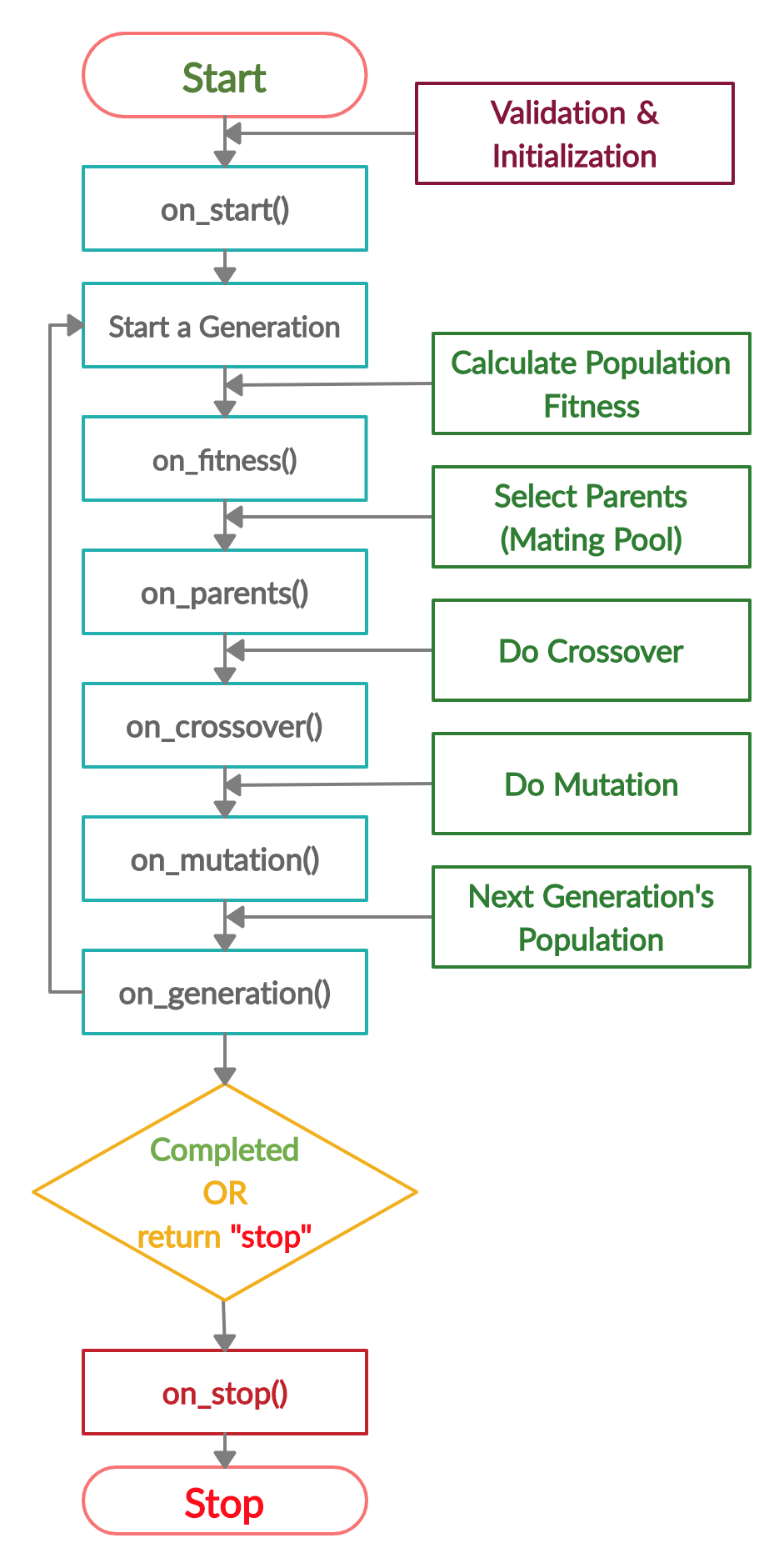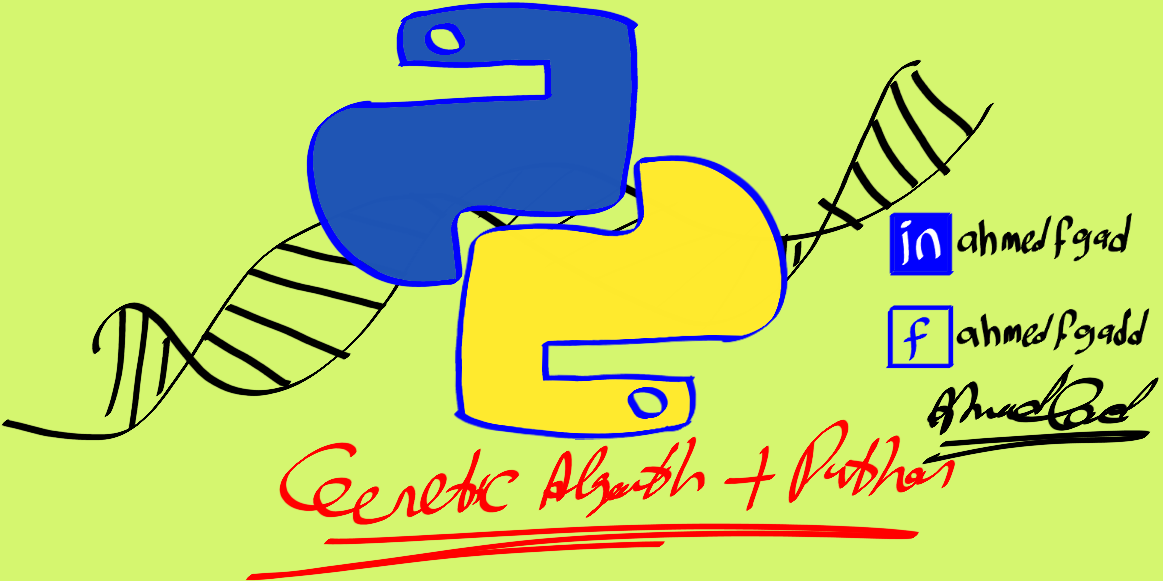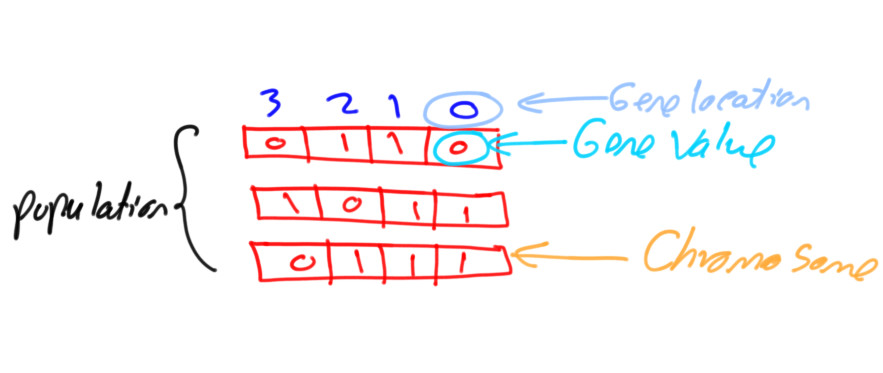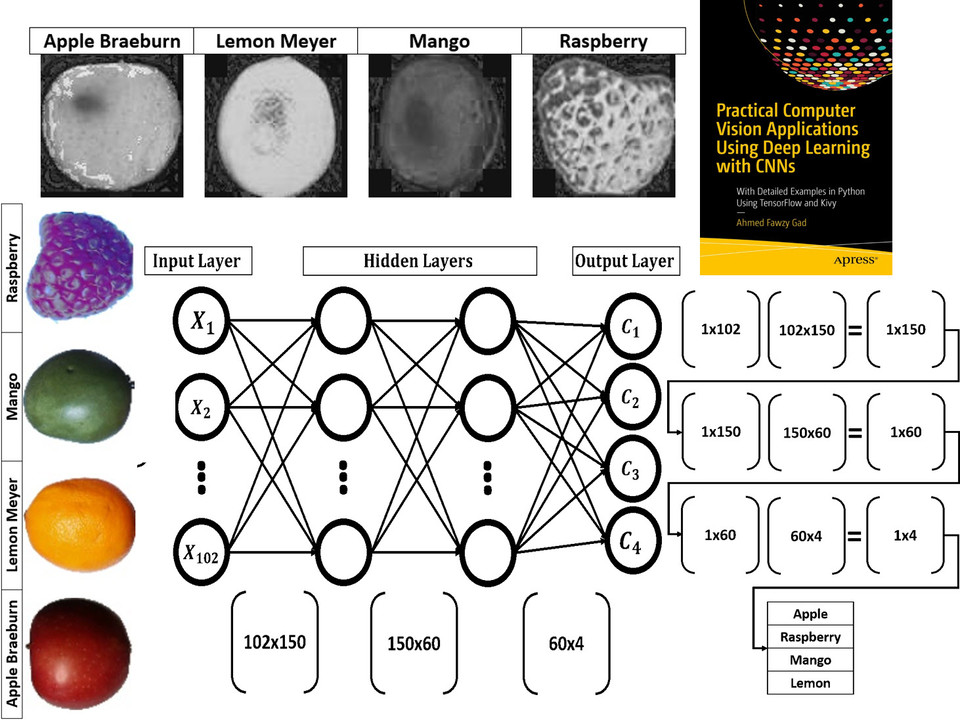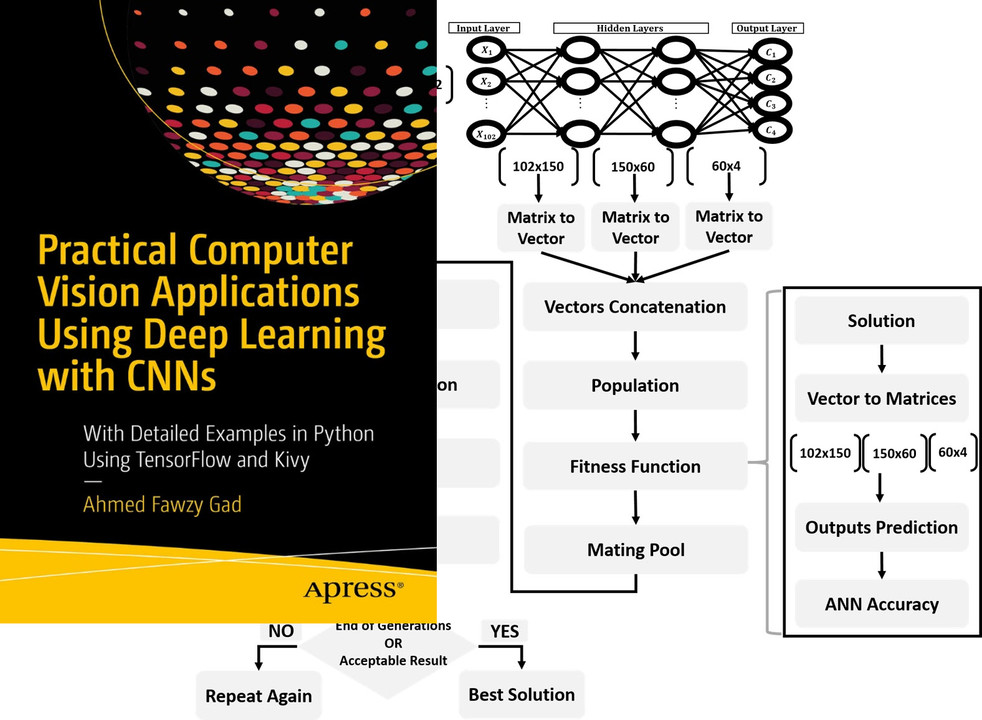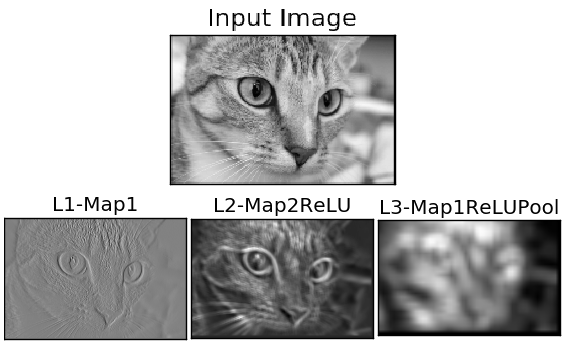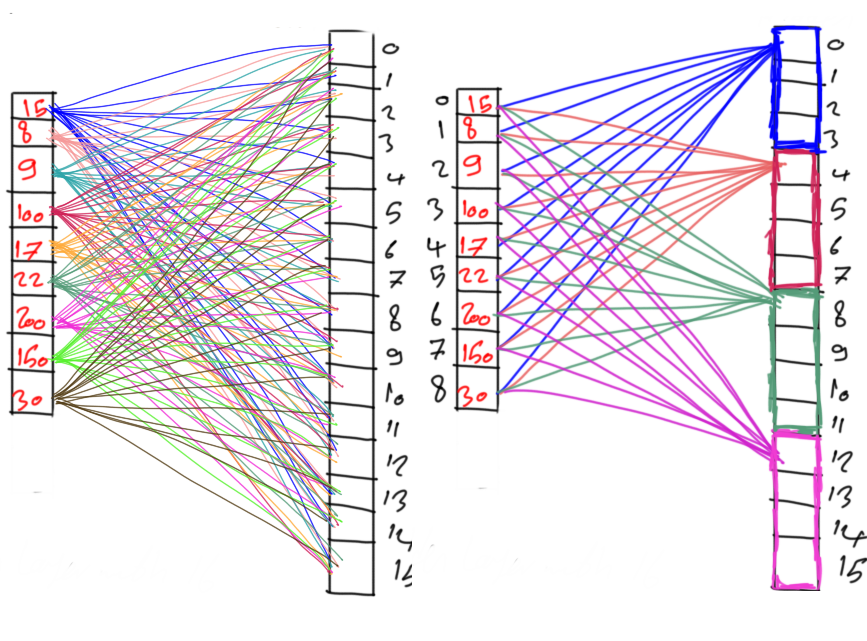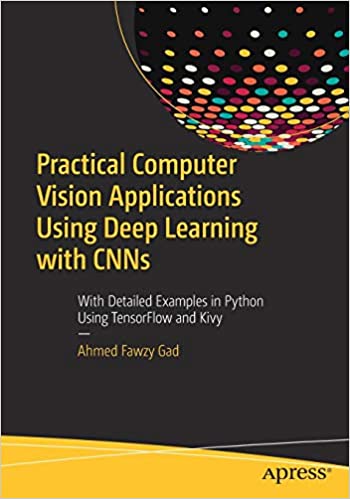TorchGA is part of the PyGAD library for training PyTorch models using the genetic algorithm (GA). This feature is supported starting from PyGAD 2.10.0.
The TorchGA project has a single module named torchga.py which has a class named TorchGA for preparing an initial population of PyTorch model parameters.
PyGAD is an open-source Python library for building the genetic algorithm and training machine learning algorithms. Check the library's documentation at Read The Docs: https://pygad.readthedocs.io
- Credit/Debit Card: https://donate.stripe.com/eVa5kO866elKgM0144
- Open Collective: opencollective.com/pygad
- PayPal: Use either this link: paypal.me/ahmedfgad or the e-mail address [email protected]
- Interac e-Transfer: Use e-mail address [email protected]
To install PyGAD, simply use pip to download and install the library from PyPI (Python Package Index). The library lives a PyPI at this page https://pypi.org/project/pygad.
pip3 install pygadTo get started with PyGAD, please read the documentation at Read The Docs https://pygad.readthedocs.io.
The source code of the PyGAD modules is found in the following GitHub projects:
- pygad: (https://github.com/ahmedfgad/GeneticAlgorithmPython)
- pygad.nn: https://github.com/ahmedfgad/NumPyANN
- pygad.gann: https://github.com/ahmedfgad/NeuralGenetic
- pygad.cnn: https://github.com/ahmedfgad/NumPyCNN
- pygad.gacnn: https://github.com/ahmedfgad/CNNGenetic
- pygad.kerasga: https://github.com/ahmedfgad/KerasGA
- pygad.torchga: https://github.com/ahmedfgad/TorchGA
The documentation of PyGAD is available at Read The Docs https://pygad.readthedocs.io.
The documentation of the PyGAD library is available at Read The Docs at this link: https://pygad.readthedocs.io. It discusses the modules supported by PyGAD, all its classes, methods, attribute, and functions. For each module, a number of examples are given.
If there is an issue using PyGAD, feel free to post at issue in this GitHub repository https://github.com/ahmedfgad/GeneticAlgorithmPython or by sending an e-mail to [email protected].
If you built a project that uses PyGAD, then please drop an e-mail to [email protected] with the following information so that your project is included in the documentation.
- Project title
- Brief description
- Preferably, a link that directs the readers to your project
Please check the Contact Us section for more contact details.
The next figure lists the different stages in the lifecycle of an instance of the pygad.GA class. Note that PyGAD stops when either all generations are completed or when the function passed to the on_generation parameter returns the string stop.
The next code implements all the callback functions to trace the execution of the genetic algorithm. Each callback function prints its name.
import pygad
import numpy
function_inputs = [4,-2,3.5,5,-11,-4.7]
desired_output = 44
def fitness_func(ga_instance, solution, solution_idx):
output = numpy.sum(solution*function_inputs)
fitness = 1.0 / (numpy.abs(output - desired_output) + 0.000001)
return fitness
fitness_function = fitness_func
def on_start(ga_instance):
print("on_start()")
def on_fitness(ga_instance, population_fitness):
print("on_fitness()")
def on_parents(ga_instance, selected_parents):
print("on_parents()")
def on_crossover(ga_instance, offspring_crossover):
print("on_crossover()")
def on_mutation(ga_instance, offspring_mutation):
print("on_mutation()")
def on_generation(ga_instance):
print("on_generation()")
def on_stop(ga_instance, last_population_fitness):
print("on_stop()")
ga_instance = pygad.GA(num_generations=3,
num_parents_mating=5,
fitness_func=fitness_function,
sol_per_pop=10,
num_genes=len(function_inputs),
on_start=on_start,
on_fitness=on_fitness,
on_parents=on_parents,
on_crossover=on_crossover,
on_mutation=on_mutation,
on_generation=on_generation,
on_stop=on_stop)
ga_instance.run()Based on the used 3 generations as assigned to the num_generations argument, here is the output.
on_start()
on_fitness()
on_parents()
on_crossover()
on_mutation()
on_generation()
on_fitness()
on_parents()
on_crossover()
on_mutation()
on_generation()
on_fitness()
on_parents()
on_crossover()
on_mutation()
on_generation()
on_stop()
Check the PyGAD's documentation for more examples information. You can also find more information about the implementation of the examples.
import torch
import torchga
import pygad
def fitness_func(ga_instance, solution, sol_idx):
global data_inputs, data_outputs, torch_ga, model, loss_function
model_weights_dict = torchga.model_weights_as_dict(model=model,
weights_vector=solution)
# Use the current solution as the model parameters.
model.load_state_dict(model_weights_dict)
predictions = model(data_inputs)
abs_error = loss_function(predictions, data_outputs).detach().numpy() + 0.00000001
solution_fitness = 1.0 / abs_error
return solution_fitness
def callback_generation(ga_instance):
print("Generation = {generation}".format(generation=ga_instance.generations_completed))
print("Fitness = {fitness}".format(fitness=ga_instance.best_solution()[1]))
# Create the PyTorch model.
input_layer = torch.nn.Linear(3, 5)
relu_layer = torch.nn.ReLU()
output_layer = torch.nn.Linear(5, 1)
model = torch.nn.Sequential(input_layer,
relu_layer,
output_layer)
# print(model)
# Create an instance of the pygad.torchga.TorchGA class to build the initial population.
torch_ga = torchga.TorchGA(model=model,
num_solutions=10)
loss_function = torch.nn.L1Loss()
# Data inputs
data_inputs = torch.tensor([[0.02, 0.1, 0.15],
[0.7, 0.6, 0.8],
[1.5, 1.2, 1.7],
[3.2, 2.9, 3.1]])
# Data outputs
data_outputs = torch.tensor([[0.1],
[0.6],
[1.3],
[2.5]])
# Prepare the PyGAD parameters. Check the documentation for more information: https://pygad.readthedocs.io/en/latest/pygad.html#pygad-ga-class
num_generations = 250 # Number of generations.
num_parents_mating = 5 # Number of solutions to be selected as parents in the mating pool.
initial_population = torch_ga.population_weights # Initial population of network weights
ga_instance = pygad.GA(num_generations=num_generations,
num_parents_mating=num_parents_mating,
initial_population=initial_population,
fitness_func=fitness_func,
on_generation=callback_generation)
ga_instance.run()
# After the generations complete, some plots are showed that summarize how the outputs/fitness values evolve over generations.
ga_instance.plot_fitness(title="PyGAD & PyTorch - Iteration vs. Fitness", linewidth=4)
# Returning the details of the best solution.
solution, solution_fitness, solution_idx = ga_instance.best_solution()
print("Fitness value of the best solution = {solution_fitness}".format(solution_fitness=solution_fitness))
print("Index of the best solution : {solution_idx}".format(solution_idx=solution_idx))
# Fetch the parameters of the best solution.
best_solution_weights = torchga.model_weights_as_dict(model=model,
weights_vector=solution)
model.load_state_dict(best_solution_weights)
predictions = model(data_inputs)
print("Predictions : \n", predictions.detach().numpy())
abs_error = loss_function(predictions, data_outputs)
print("Absolute Error : ", abs_error.detach().numpy())import torch
import torchga
import pygad
def fitness_func(ga_instance, solution, sol_idx):
global data_inputs, data_outputs, torch_ga, model, loss_function
model_weights_dict = torchga.model_weights_as_dict(model=model,
weights_vector=solution)
# Use the current solution as the model parameters.
model.load_state_dict(model_weights_dict)
predictions = model(data_inputs)
solution_fitness = 1.0 / (loss_function(predictions, data_outputs).detach().numpy() + 0.00000001)
return solution_fitness
def callback_generation(ga_instance):
print("Generation = {generation}".format(generation=ga_instance.generations_completed))
print("Fitness = {fitness}".format(fitness=ga_instance.best_solution()[1]))
# Create the PyTorch model.
input_layer = torch.nn.Linear(2, 4)
relu_layer = torch.nn.ReLU()
dense_layer = torch.nn.Linear(4, 2)
output_layer = torch.nn.Softmax(1)
model = torch.nn.Sequential(input_layer,
relu_layer,
dense_layer,
output_layer)
# print(model)
# Create an instance of the pygad.torchga.TorchGA class to build the initial population.
torch_ga = torchga.TorchGA(model=model,
num_solutions=10)
loss_function = torch.nn.BCELoss()
# XOR problem inputs
data_inputs = torch.tensor([[0.0, 0.0],
[0.0, 1.0],
[1.0, 0.0],
[1.0, 1.0]])
# XOR problem outputs
data_outputs = torch.tensor([[1.0, 0.0],
[0.0, 1.0],
[0.0, 1.0],
[1.0, 0.0]])
# Prepare the PyGAD parameters. Check the documentation for more information: https://pygad.readthedocs.io/en/latest/pygad.html#pygad-ga-class
num_generations = 250 # Number of generations.
num_parents_mating = 5 # Number of solutions to be selected as parents in the mating pool.
initial_population = torch_ga.population_weights # Initial population of network weights.
# Create an instance of the pygad.GA class
ga_instance = pygad.GA(num_generations=num_generations,
num_parents_mating=num_parents_mating,
initial_population=initial_population,
fitness_func=fitness_func,
on_generation=callback_generation)
# Start the genetic algorithm evolution.
ga_instance.run()
# After the generations complete, some plots are showed that summarize how the outputs/fitness values evolve over generations.
ga_instance.plot_fitness(title="PyGAD & PyTorch - Iteration vs. Fitness", linewidth=4)
# Returning the details of the best solution.
solution, solution_fitness, solution_idx = ga_instance.best_solution()
print("Fitness value of the best solution = {solution_fitness}".format(solution_fitness=solution_fitness))
print("Index of the best solution : {solution_idx}".format(solution_idx=solution_idx))
# Fetch the parameters of the best solution.
best_solution_weights = torchga.model_weights_as_dict(model=model,
weights_vector=solution)
model.load_state_dict(best_solution_weights)
predictions = model(data_inputs)
print("Predictions : \n", predictions.detach().numpy())
# Calculate the binary crossentropy for the trained model.
print("Binary Crossentropy : ", loss_function(predictions, data_outputs).detach().numpy())
# Calculate the classification accuracy of the trained model.
a = torch.max(predictions, axis=1)
b = torch.max(data_outputs, axis=1)
accuracy = torch.sum(a.indices == b.indices) / len(data_outputs)
print("Accuracy : ", accuracy.detach().numpy())There are different resources that can be used to get started with the building CNN and its Python implementation.
To start with coding the genetic algorithm, you can check the tutorial titled Genetic Algorithm Implementation in Python available at these links:
This tutorial is prepared based on a previous version of the project but it still a good resource to start with coding the genetic algorithm.
Get started with the genetic algorithm by reading the tutorial titled Introduction to Optimization with Genetic Algorithm which is available at these links:
Read about building neural networks in Python through the tutorial titled Artificial Neural Network Implementation using NumPy and Classification of the Fruits360 Image Dataset available at these links:
Read about training neural networks using the genetic algorithm through the tutorial titled Artificial Neural Networks Optimization using Genetic Algorithm with Python available at these links:
To start with coding the genetic algorithm, you can check the tutorial titled Building Convolutional Neural Network using NumPy from Scratch available at these links:
This tutorial) is prepared based on a previous version of the project but it still a good resource to start with coding CNNs.
Get started with the genetic algorithm by reading the tutorial titled Derivation of Convolutional Neural Network from Fully Connected Network Step-By-Step which is available at these links:
You can also check my book cited as Ahmed Fawzy Gad 'Practical Computer Vision Applications Using Deep Learning with CNNs'. Dec. 2018, Apress, 978-1-4842-4167-7 which discusses neural networks, convolutional neural networks, deep learning, genetic algorithm, and more.
Find the book at these links:
If you used PyGAD, please consider adding a citation to the following paper about PyGAD:
@misc{gad2021pygad,
title={PyGAD: An Intuitive Genetic Algorithm Python Library},
author={Ahmed Fawzy Gad},
year={2021},
eprint={2106.06158},
archivePrefix={arXiv},
primaryClass={cs.NE}
}

